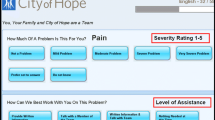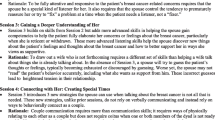Abstract
This study examined the helping process that occurred when 26 breast cancer patients (the disclosers) talked about their illness-related concerns with their partner and, in a separate conversation, with a fellow patient (the volunteer helpers). The conversations were rated by trained observers and by the disclosers in terms of several process and outcome variables. From the observers' perspective, the volunteer helpers were more helpful, empathic, and supportive, less critical, and used more self-disclosure than the partners. Disclosers did not differentiate between the two types of helper, and gave generally high ratings to both conversations. Strengths and weaknesses of each type of helper were identified. Findings are discussed in relation to the literature on formal and informal helping, and implications for training nonprofessional helpers are suggested.
Similar content being viewed by others
REFERENCES
Barker, C., & Lemle, R. (1984). The helping process in couples. American Journal of Community Psychology, 12, 321–336.
Barker, C., & Lemle, R. (1987). Informal helping in partner and stranger dyads. Journal of Marriage and the Family, 49, 541–547.
Barker, C., Pistrang, N., Shapiro, D. A., & Shaw, I. (1990). Coping and help-seeking in the UK adult population. British Journal of Clinical Psychology, 29, 271–285.
Blood, R. V., & Wolfe, D. M. (1960). Husbands and wives: The dynamics of married living. New York: Free Press.
Borkman, T. J. (1990). Experiential, professional, and lay frames of reference. In T. J. Powell (Ed.), Working with self-help (pp. 3–30). Silver Springs, MD: NASW Press.
Breast Cancer Care. (1995). Volunteer Service Guidelines. London: Author.
Burke, R. J., & Weir, T. (1977). Husband-wife helping relationships: The “mental hygiene” function in marriage. Psychological Reports, 40, 911–915.
Cella, D. F., Sarafian, B., Snider, P. R., Yellen, S. B., & Winicour, P. (1993). Evaluation of a community-based cancer support group. Psycho-Oncology, 2, 123–132.
Christensen, A., & Jacobson, N. S. (1994). Who (or what) can do psychotherapy: The status and challenge of nonprofessional therapies. Psychological Science, 5, 8–14.
Cowen, E. (1982). Help is where you find it: Four informal helping groups. American Psychologist, 37, 385–395.
Cox, A. D. (1993). Befriending young mothers. British Journal of Psychiatry, 163, 6–18.
Coyne, J. C. (1976). Toward an interactional description of depression. Psychiatry, 39, 28–40.
Coyne, J. C., Ellard, J. H., & Smith, D. A. F. (1990). Social support, interdependence, and the dilemmas of helping. In B. R. Sarason, I. G. Sarason, & G. R. Pierce (Eds.), Social support: An interactional view (pp. 129–149). New York: Wiley.
Derogatis, L. (1977). SCL-90 Administration, scoring, and procedures manual. Baltimore, MD: Johns Hopkins University Press.
Durlak, J. A. (1979). Comparative effectiveness of paraprofessional and professional helpers. Psychological Bulletin, 86, 80–92.
Elliott, R. (1985). Helpful and nonhelpful events in brief counseling interviews: An empirical taxonomy. Journal of Counseling Psychology, 32, 307–322.
Goodman, G. (1972). Companionship therapy: Studies in structured intimacy. San Francisco: Jossey-Bass.
Gruder, C., Mermelstein, R., Kirkendol, S., Hedeker, D., Wong, S. C., Schreckengost, Warnecke, R. B., Burzette, R., & Miller, T. (1993). Effects of social support and relapse prevention training as adjuncts to a televised smoking-cessation intervention. Journal of Consulting and Clinical Psychology, 61, 113–120
Guerney, B. G. (1977). Relationship enhancement: Skill-training programs for therapy, problem prevention and enrichment. San Francisco: Jossey-Bass.
Helgeson, V. S., & Cohen, S. (1996). Social support and adjustment to cancer: Reconciling descriptive, correlational, and intervention research. Health Psychology, 15, 135–148.
Helman, C. G. (1990). Culture, health and illness: An introduction for health professionals (2nd ed.). London: Wright.
Humphreys, K., & Rappaport, J. (1994). Researching self-help/mutual aid groups and organizations: Many roads, one journey. Applied and Preventive Psychology, 3, 217–231.
Jacobs, M. K., & Goodman, G. (1989). Psychology and self-help groups: Predictions on a partnership. American Psychologist, 44, 536–545.
Lambert, M. J., & Bergin, A. E. (1994). The effectiveness of psychotherapy. In A. E. Bergin & S. L. Garfield (Eds.), Handbook of psychotherapy and behavior change (4th ed., pp. 143–189). New York: Wiley.
Lambert, M. J., & Hill, C. E. (1994). Assessing psychotherapy outcomes and processes. In A. E. Bergin & S. L. Garfield (Eds.), Handbook of psychotherapy and behavior change (4th ed., pp. 72–113). New York: Wiley.
Lebow, J. (1984). Research assessing consumer satisfaction with mental health treatment: A review of findings. Evaluation and Program Planning, 6, 211–236.
Meyer, T. J., & Mark, M. M. (1995). Effects of psychosocial interventions with adult cancer patients: A meta-analysis of randomized experiments. Health Psychology, 14, 101–108.
Nye, F. I. (1976). Role structure and analysis of the family. Beverley Hills: Sage.
Pennebaker, J. W. (Ed.) (1995). Emotion, disclosure, and health. Washington, DC: American Psychological Association.
Pistrang, N., & Barker, C. (1992). Disclosure of concerns in breast cancer. Psycho-Oncology, 1, 183–192.
Pistrang, N., & Barker, C. (1995). The partner relationship in psychological response to breast cancer. Social Science and Medicine, 40, 789–797.
Pistrang, N., Barker, C., & Rutter, C. (1997). Social support as conversation: Analysing breast cancer patients' interactions with their partners. Social Science and Medicine, 45, 773–782.
Powell, T. J. (1990). Self-help, professional help, and informal help: Competing or complementary systems? In T. J. Powell (Ed.), Working with self-help (pp. 31–49). Silver Springs, MD: NASW Press.
Reisman, J. M., & Yamokoski, T. (1974). Psychotherapy and friendship: An analysis of the communication of friends. Journal of Counseling Psychology, 21, 269–273.
Reppucci, N. D. (1990). Ecological validity and the deritualization of process. In P. Tolan, C. Keys, F. Chertok, & L. Jason (Eds.), Researching community psychology: Issues of theory and methods (pp. 160–163). Washington, DC: American Psychological Association.
Rogers, C. R. (1957). The necessary and sufficient conditions for therapeutic personality change. Journal of Consulting Psychology, 21, 95–103.
Rutter, C. (1993). How breast cancer patients and their partners talk about their concerns. Unpublished Masters thesis, Sub-Department of Clinical Health Psychology, University College London, London, England.
Sarason, B., Sarason, I. G., Hacker, T. A., & Basham, R. B. (1985). Concomitants of social support: Social skills, physical attractiveness, and gender. Journal of Personality and Social Psychology, 49, 469–480.
Spanier, G. B. (1976). Measuring dyadic adjustment: New scales for assessing the quality of marriage and similar dyads. Journal of Marriage and the Family, 38, 15–28.
Spiegel, D., Bloom, J. R., Kraemer, H. C., & Gottheil, E. (1989). Effect of psychosocial treatment on survival of patients with metastatic breast cancer. Lancet, 888–891.
Tannen, D. (1990). You just don't understand: Women and men in conversation. New York: William Morrow.
Tannen, D. (1994). Gender and discourse. New York: Oxford University Press.
Veroff, J., Kulka, R. A., & Douvan, E. (1981). Mental health in America: Patterns of help-seeking from 1957 to 1976. New York: Basic Books.
Wanigaratne, S. D., & Barker, C. (1995). Clients' preferences for styles of therapy. British Journal of Clinical Psychology, 34, 215–222.
Weiss, R. L., & Heyman, R. E. (1990). Observation of marital interaction. In F. D. Fincham & T. N. Bradbury (Eds.), The psychology of marriage: Basic issues and applications (pp. 87–117). New York: Guilford.
Wills, T. A., & DePaulo, B. M. (1991). Interpersonal analysis of the help-seeking process. Handbook of Social and Clinical Psychology. New York: Pergamon.
Author information
Authors and Affiliations
Rights and permissions
About this article
Cite this article
Pistrang, N., Barker, C. Partners and Fellow Patients: Two Sources of Emotional Support for Women with Breast Cancer. Am J Community Psychol 26, 439–456 (1998). https://doi.org/10.1023/A:1022163205450
Issue Date:
DOI: https://doi.org/10.1023/A:1022163205450




